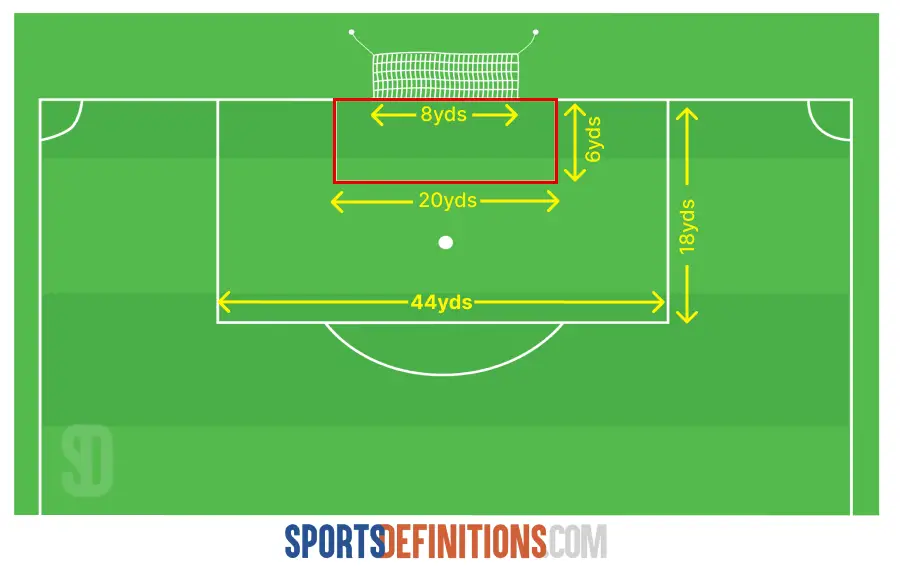Six-yard box
Even though the lines on a soccer pitch might seem not only confusing but rather redundant at times, each and every single one of the markings is vital to the game.
What does the 6-yard box represent?
The 6-yard box, located just outside of the goal, is the only place on the entire pitch where the attacking team cannot take an indirect free kick. It’s also the area where the team starting a new attacking phase (and has been defending in the previous scenario) has to take a goal kick.

If you’re used to watching soccer, you’ve probably noticed that the goalkeeper tends to put the ball on the 6-yard line before kicking it back into the play. In theory, the goal kick could be taken from any spot within the area, but goalkeepers tend to place the ball directly on the line to utilize the goal kick to the fullest.
Why is there a 6-yard box in the first place?
Imagine your team starting the attacking phase after the opposition had a chance. The opposing team in this scenario just made a shot and missed – the ball is out of play.
Now, your goalkeeper (or in some cases even an outfield player) is ready to kick the ball back into play. Where do you think the GK would place the ball? If there is no limit or a marked zone where the GK could take the kick, would that mean that the goal kick could be taken from anywhere inside the penalty box?
You probably get an idea why the team that’s starting an attacking phase can only kick the ball from within the 6-yard box. Anywhere further than that gives a huge advantage to the team starting the attack, since the GK could easily kick the ball into the opposing penalty box.
The other major reason for having the 6-yard box, as mentioned briefly in the previous paragraph, is that it is the only area on the entire pitch from which the opposing team cannot take an indirect free kick.
What is an indirect free kick you might ask?
An indirect free kick is a kick taken from inside the box that is NOT a penalty. In a scenario where a defender on your team kicks the ball back to the GK, the only thing the GK could do is either pass or kick the ball. If the GK for some reason makes a mistake and catches the ball with their hands, the referee will call for an indirect free kick.
This can potentially complicate things for the defending team. The attacking team will have a quite good chance to score, and in the majority of cases, if the attacking team plays their cards right, a good scoring chance will occur.
Now, how does a 6-yard box fit into all of this?
As previously mentioned, if a similar scenario happens inside the 6-yard box, the indirect free kick could only be taken from the outer side of it, and never from the inside area.
The importance of the 6-yard box doesn’t only apply to the indirect free-kick rule.
It is also the area where the goalkeepers have an advantage over the attacking players in aerial duels.
This means that if for example, the attacking team takes a corner kick, the goalkeeper of the defending team will almost always get a foul in case one of the attacking players is slightly aggressive. This, of course, only applies to the 6-yard box. If, for some reason, a goalkeeper has a duel with an opposing player outside of the box, there are no privileges for the defending GK.
Is a goalkeeper the only player on the pitch who can take the goal kick in the 6 yard box when starting an attacking phase?
As we briefly mentioned in the first half of the article, no, the goalkeeper is not the only player who can kick the ball back into play.
There are many scenarios in which a goalkeeper suffers an injury during a match and just cannot risk a potentially worse injury by taking a goal kick. That’s where an outfield player usually comes into play. It is almost always a defender, or to be more precise a center-back who will kick the ball into the opposing half.
Even though this does not happen very often, make sure to keep an eye on the number of unused substitutes of a team next time you watch a game. In case a team has used up all of them, they will be unable to substitute a potentially injured goalkeeper.
Final thoughts
The soccer pitch, as large as it is, doesn’t have that many markings as for example a football field. The reason why the biggest number of lines is concentrated around the 6 yard box shows the importance of this particular area.
Even if a player loses focus on any other part of the pitch, that might not be as bad as if a mistake has occurred in the box, especially in the 6 yard box.
The sport has developed quite a bit during the last century, and even though the 6 yard box might seem just like any other part of a soccer field, you probably understand that’s not actually the case.
